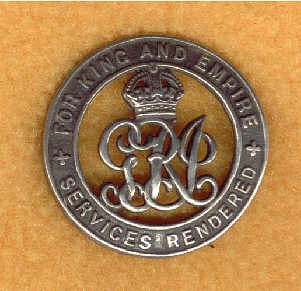This badge, also known as the Wound Badge or Services Rendered Badge, was given to wounded soldiers who were honourably discharged from the British armed services during World War I.

The Silver War Badge had an initial issue of around 355,000 between Sep 1916 and March 1918. These have plain numbers on the rear and are of better quality than subsequent stampings. A second series from March 1918 up to Sep 1918 took the numbers up to 450,000. A third series from Sep 1918 to Dec 1919 have a 'B' prefix and are numbered from 1 up to 450,000. From Dec 1919 to Jan 1920 about 5,000 were issued, with 'O' prefix. From Jan 1920 to Mar 1922 the series had plain numbers and ran from 450,000 to about 520,000. After 1 Apr 1918, RAF men were issued with badges prefixed RAF and over 10,000 were issued. The Royal Navy also had a separate series, prefixed 'RN' with at least 43,000 issued. As well as servicemen, civilians who served in the RAMC, female nurses, VADs, QMAAC staff, etc. were also awarded Silver War Badges, and some also appear to have been issued to Merchant Navy men.
The "SWB List" means the Silver War Badge List implying that he received a medical discharge.